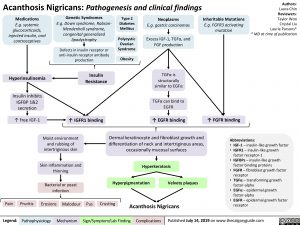Acanthosis Nigricans: Pathogenesis and clinical findings
Authors: Laura Chin Reviewers: Taylor Woo Crystal Liu Laurie Parsons* * MD at time of publication
Medications
E.g. systemic glucocorticoids, injected insulin, oral contraceptives
Hyperinsulinemia
Insulin inhibits IGFBP 1&2 secretion
Genetic Syndromes
E.g. Down syndrome, Rabson- Mendenhall syndrome, congenital generalized lipodystrophy
Defects in insulin receptor or anti-insulin receptor antibody production
Insulin Resistance
↑ IGFR1 binding
Type 2 Diabetes Mellitus
Polycystic Ovarian Syndrome
Obesity
Neoplasms
E.g. gastric carcinomas
Excess IGF-1, TGFα, and FGF production
TGFα is structurally similar to EGFα
TGFα can bind to EGFR
↑ EGFR binding
Inheritable Mutations
E.g. FGFR3 activating mutation
↑ free IGF-1
↑ FGFR binding
Moist environment and rubbing of intertriginous skin
Skin inflammation and thinning
Bacterial or yeast infection
Erosions Malodour
Dermal keratinocyte and fibroblast growth and differentiation of neck and intertriginous areas, occasionally mucosal surfaces
Hyperkeratosis
Abbreviations:
• IGF-1 – insulin-like growth factor • IGFR1 – insulin-like growth
factor receptor-1
• IGFBPs – insulin-like growth
factor binding proteins
• FGFR – fibroblast growth factor
receptor
• TGFα – transforming growth
factor-alpha
• EGFα – epidermal growth
factor-alpha
• EGFR – epidermal growth factor
receptor
Hyperpigmentation
Crusting
Velvety plaques
Pain
Pruritis
Pus
Acanthosis Nigricans
Legend:
Pathophysiology
Mechanism
Sign/Symptom/Lab Finding
Complications
Published July 14, 2019 on www.thecalgaryguide.com
Foundations
Systems
Other Languages
Dermatology Pigmented Skin Lesions Acanthosis Nigricans: Pathogenesis and clinical findings acanthosis-nigricans-pathogenesis-and-clinical-findings

